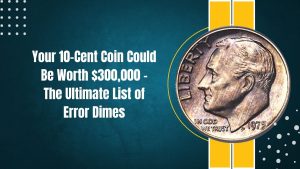Collecting rare coins is a pursuit that combines historical intrigue with the potential for substantial financial gain. Among the myriad of coins that have captivated collectors and investors alike, three stand out for their exceptional rarity and staggering market values. Let’s delve into these numismatic treasures, each with a rich history and a price tag that reflects their significance.
Contents
1. The 1933 Double Eagle
Historical Significance: The 1933 Double Eagle is a $20 gold coin that was never officially circulated. In 1933, amidst the Great Depression, President Franklin D. Roosevelt took the United States off the gold standard, leading to the melting down of these coins before they could be issued. However, a few specimens escaped destruction, making them exceedingly rare.
Market Value: In June 2021, a 1933 Double Eagle sold at a Sotheby’s auction for a record-breaking $18.9 million, making it the most expensive coin ever sold.
Notable Features:
- Design: The obverse features Lady Liberty striding forward, holding a torch and an olive branch, symbolizing enlightenment and peace. The reverse showcases a majestic eagle in flight.
- Rarity: Due to the recall and melting of these coins, only a handful are known to exist today.
2. The 1794 Flowing Hair Silver Dollar
Historical Significance: Believed to be among the first silver dollars minted by the United States, the 1794 Flowing Hair Silver Dollar represents the young nation’s initial steps into establishing its own currency system.
Market Value: In January 2013, a specimen of this coin sold for $12 million in a private sale, setting a record at the time for the highest amount ever paid for a single coin.
Notable Features:
- Design: The obverse depicts Lady Liberty with flowing hair, while the reverse features an eagle surrounded by a wreath.
- Rarity: As one of the earliest silver dollars, surviving specimens are extremely scarce, especially in high grades.
3. The 1787 Brasher Doubloon
Historical Significance: The Brasher Doubloon is a gold coin privately minted by Ephraim Brasher, a New York City goldsmith and silversmith. At a time when the U.S. was in its infancy and lacked a standardized currency, Brasher’s coins filled a crucial gap in commerce.
Market Value: In January 2021, a Brasher Doubloon with Brasher’s hallmark on the eagle’s breast sold for $9.36 million, highlighting its immense value to collectors.
Notable Features:
- Design: The obverse bears the image of a rising sun over a mountain, with the motto “Nova Eboraca Columbia Exceelsior,” translating to “New York and America, Ever Higher.” The reverse features an eagle with a shield.
- Rarity: As a privately minted coin, only a few examples exist, each with slight variations, adding to their uniqueness.
| Coin Name | Year | Notable Features | Recent Sale Price |
|---|---|---|---|
| 1933 Double Eagle | 1933 | Never circulated; most melted down; few specimens exist | $18.9 million |
| 1794 Flowing Hair Dollar | 1794 | Among the first U.S. silver dollars; depicts Lady Liberty with flowing hair | $12 million |
| 1787 Brasher Doubloon | 1787 | Privately minted gold coin; features Brasher’s hallmark; unique design elements | $9.36 million |
Investing in rare coins requires a deep appreciation for history, meticulous research, and consultation with experts. The stories behind these coins offer a fascinating glimpse into the past, and their significant market values reflect the esteem in which they are held by collectors worldwide.
FAQs
Why are these coins so valuable?
Their value stems from a combination of historical significance, rarity, and condition. Coins like the 1933 Double Eagle were never circulated, making surviving specimens exceptionally rare.
How can I determine the value of a rare coin?
Consulting with professional numismatists or reputable coin dealers is essential. They can assess factors such as rarity, demand, condition, and historical importance to provide an accurate valuation.
Where can I purchase rare coins?
Rare coins can be purchased through auctions, reputable coin dealers, and numismatic shows. It’s crucial to verify the authenticity and provenance of the coin before making a purchase.
What should I consider before investing in rare coins?
Consider factors such as authenticity, market demand, historical significance, and the coin’s condition. Consulting with experts and conducting thorough research is advisable.
How should I store and protect rare coins?
Store coins in a controlled environment with stable temperature and humidity. Using protective holders or cases can prevent physical damage. Avoid handling coins directly to preserve their condition.







